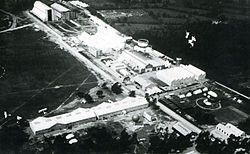RAE Farnborough
| Royal Aircraft Establishment | |
|---|---|
| Farnborough, Hampshire | |

Royal Aircraft Factory (RAF) c.1915
|
|
| Coordinates | 51°16′46″N 0°47′17″W / 51.279475°N 0.787926°W |
| Type | Research establishment |
| Site information | |
| Owner |
War Office (1904–1964) Ministry of Defence (1964–1988) |
| Controlled by |
|
| Site history | |
| In use | 1904–1988 |
| Battles/wars |
First World War Second World War |
The Royal Aircraft Establishment (RAE) was a British research establishment, known by several different names during its history, that eventually came under the aegis of the UK Ministry of Defence (MoD), before finally losing its identity in mergers with other institutions.
The first site was at Farnborough Airfield ("RAE Farnborough") in Hampshire to which was added a second site RAE Bedford (Bedfordshire) in 1946.
In 1988 it was renamed the Royal Aerospace Establishment before merging with other research entities to become part of the new Defence Research Agency in 1991.
In 1904–1906 the Army Balloon Factory, which was part of the Army School of Ballooning, under the command of Colonel James Templer, relocated from Aldershot to the edge of Farnborough Common in order to have enough space to inflate the new "dirigible balloon" or airship which was then under construction. Templer's place was taken by Colonel John Capper and Templer himself retired in 1908. Besides balloons and airships, the factory also experimented with Samuel Franklin Cody's war kites and aeroplanes designed both by Cody and J. W. Dunne. In October 1908 Cody made the first aeroplane flight in Britain at Farnborough.
In 1909 Army work on aeroplanes ceased and the Factory was brought under civilian control. Capper was replaced as Superintendent by Mervyn O'Gorman. In 1912 the Balloon Factory was renamed the Royal Aircraft Factory (RAF). Its first new designer was Geoffrey de Havilland who later founded his own company. later colleagues included John Kenworthy who became chief engineer and designer at the Austin Motor Company in 1918 and who went on to found the Redwing Aircraft Co in 1930 (Flight International) and Henry Folland – later chief designer at Gloster Aircraft Company, and founder of his own company Folland Aircraft. One of the designers in the engine department was Samuel Heron, who later went on to invent the sodium-filled poppet valve, instrumental in achieving greater powers from piston engines. While at the RAF, Heron designed a radial engine that he was not able to build during his time there, however upon leaving the RAF he then went to Siddeley-Deasy where the design, the RAF.8, was developed as the Jaguar. Heron later moved to the United States where he worked on the design of the Wright Whirlwind. Other engineers included Major F.M. Green, G.S. Wilkinson, James E. "Jimmy" Ellor, Prof. A.H. Gibson, and A.A. Griffith. Both Ellor and Griffith would later go on to work for Rolls-Royce Limited.
...
Wikipedia
